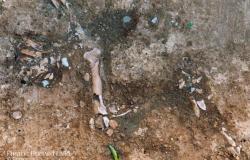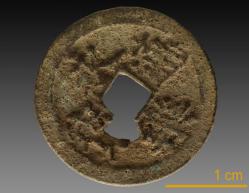INSTITUT SUPERIEUR D'ANTHROPOLOGIE
INSTITUTE OF ANTHROPOLOGY
ONLINE COURSES / COURS A DISTANCE
SPRING SESSION : APRIL 2013
REGISTER NOW
FRANCE –  Sanary - Les renseignements historiques sur l’évolution de la ville depuis l’Antiquité sont peu nombreux et incomplets. Aussi toute opportunité est saisie. Mais visiblement ce chantier n'aura pas permis de mettre à jour de grandes structures permettant d'envisager une fouille à proprement parler. Les os d'un équidé ont été retrouvés. Henri Ribot (centre archéologique du Var, foyer Pierre Singal) avait été également sollicité lors de ce court sondage, ce dernier nous disait: "c'est une zone où il y a des vestiges à proximité comme la nécropole rue de la Prud'homie. Je n'ai pas eu encore la copie du compte rendu, mais d'après ce que je sais il n'y avait pas d'intérêt majeur pour aller plus loin. Les os ont été retrouvés dans le premier substrat, c'est forcément ancien, mais difficile d'établir la date exacte, ça peut-être le Moyen-Age, l'Antiquité". Et ce dernier de nous expliquer que selon le site où un permis de construire est délivré, le préfet de région et son service archéologique peuvent prescrire un diagnostic archéologique. Par contre la zone qui sera prochainement le théâtre de fouilles archéologiques majeures se trouve du côté de La Chaberte, à la Garde, où les traces d'une villa gallo-romaine ont été mises en évidence.
Sanary - Les renseignements historiques sur l’évolution de la ville depuis l’Antiquité sont peu nombreux et incomplets. Aussi toute opportunité est saisie. Mais visiblement ce chantier n'aura pas permis de mettre à jour de grandes structures permettant d'envisager une fouille à proprement parler. Les os d'un équidé ont été retrouvés. Henri Ribot (centre archéologique du Var, foyer Pierre Singal) avait été également sollicité lors de ce court sondage, ce dernier nous disait: "c'est une zone où il y a des vestiges à proximité comme la nécropole rue de la Prud'homie. Je n'ai pas eu encore la copie du compte rendu, mais d'après ce que je sais il n'y avait pas d'intérêt majeur pour aller plus loin. Les os ont été retrouvés dans le premier substrat, c'est forcément ancien, mais difficile d'établir la date exacte, ça peut-être le Moyen-Age, l'Antiquité". Et ce dernier de nous expliquer que selon le site où un permis de construire est délivré, le préfet de région et son service archéologique peuvent prescrire un diagnostic archéologique. Par contre la zone qui sera prochainement le théâtre de fouilles archéologiques majeures se trouve du côté de La Chaberte, à la Garde, où les traces d'une villa gallo-romaine ont été mises en évidence.
http://www.six-fours.net/actualite/sanary-patrimoine-au-sujet-des-sondages-archeologiques-pres-du-commissariat-6773.html
ROYAUME UNI – Flint - Archaeologists have praised builders for helping them save historic Roman finds in Flint. Anwyl Construction halted work on the Croes Atti housing development after uncovering evidence of a Roman era industrial site – including a well-preserved section of Roman road dating back about 2,000 years. As well as the Roman road archaeologists also found buildings where lead mined on nearby Halkyn Mountain was smelted before being shipped, probably by barge, down the River Dee to Chester. Among the finds were fragments of high quality Samianware pottery, probably made in what is now southern France, a silver denarius from the reign of the Emperor Domitian, 81-96AD, a hob-nailed boot found in an old well and remains of amphorae, pottery vessels which held wine.
http://www.flintshirechronicle.co.uk/flintshire-news/local-flintshire-news/2013/03/14/archaeologists-praise-builders-after-historic-find-in-flint-51352-32981788/
KENYA –  Manda - An expedition of archaeologists has unearthed a 600-year-old Chinese coin on the island of Manda, off the northern coast of Kenya. “This finding is significant. We know Africa has always been connected to the rest of the world, but this coin opens a discussion about the relationship between China and Indian Ocean nations,” said Dr Chapurukha Kusimba of the Field Museum, who co-led the expedition with Dr Sloan Williams of the University of Illinois at Chicago. The coin is a small disk of copper and silver with a square hole in the center. It is called ‘Yongle Tongbao,’ and was issued by Emperor Yongle who reigned from AD 1403 to 1425 during the Ming Dynasty. The emperor’s name is written on the coin, making it easy to date. Emperor Yongle, who started construction of China’s Forbidden City, was interested in political and trade missions to the lands that ring the Indian Ocean and sent Admiral Zheng He, also known as Cheng Ho, to explore those shores. “Zheng He was, in many ways, the Christopher Columbus of China. It’s wonderful to have a coin that may ultimately prove he came to Kenya,” Dr Kusimba said. That relationship stopped soon after Emperor Yongle’s death when later Chinese rulers banned foreign expeditions, allowing European explorers to dominate the Age of Discovery and expand their countries’ empires. The island of Manda was home to an advanced civilization from about AD 200 to 1430, when it was abandoned and never inhabited again. Trade played an important role in the development of Manda, and this coin may show trade’s importance on the island dating back to much earlier than previously thought.
Manda - An expedition of archaeologists has unearthed a 600-year-old Chinese coin on the island of Manda, off the northern coast of Kenya. “This finding is significant. We know Africa has always been connected to the rest of the world, but this coin opens a discussion about the relationship between China and Indian Ocean nations,” said Dr Chapurukha Kusimba of the Field Museum, who co-led the expedition with Dr Sloan Williams of the University of Illinois at Chicago. The coin is a small disk of copper and silver with a square hole in the center. It is called ‘Yongle Tongbao,’ and was issued by Emperor Yongle who reigned from AD 1403 to 1425 during the Ming Dynasty. The emperor’s name is written on the coin, making it easy to date. Emperor Yongle, who started construction of China’s Forbidden City, was interested in political and trade missions to the lands that ring the Indian Ocean and sent Admiral Zheng He, also known as Cheng Ho, to explore those shores. “Zheng He was, in many ways, the Christopher Columbus of China. It’s wonderful to have a coin that may ultimately prove he came to Kenya,” Dr Kusimba said. That relationship stopped soon after Emperor Yongle’s death when later Chinese rulers banned foreign expeditions, allowing European explorers to dominate the Age of Discovery and expand their countries’ empires. The island of Manda was home to an advanced civilization from about AD 200 to 1430, when it was abandoned and never inhabited again. Trade played an important role in the development of Manda, and this coin may show trade’s importance on the island dating back to much earlier than previously thought.
http://www.sci-news.com/archaeology/article00936.html